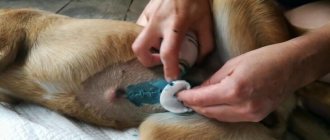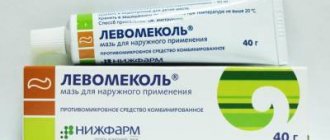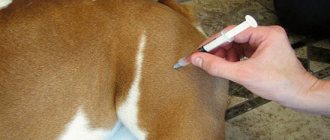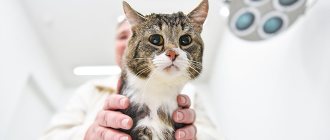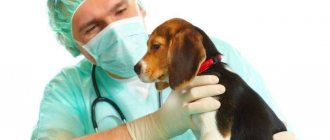Pyometra in dogs is a disease that affects the animal's uterus. It is characterized by inflammation of its mucous membrane and the presence of pus in the cavity. It can occur both acutely and chronically. This disease is most common in dogs aged 7-8 years. Relevant both for domestic animals and for bitches participating in breeding in nurseries.
The most susceptible to pyometra in dogs are animals that have never whelped, or those that mate uncontrollably. Also at risk are bitches prone to false pregnancy, which indicates hormonal disorders in the animal’s body. Lack of adequate nutrition and essential vitamins is an additional factor of ill-being.
Pyometra in dogs and its symptoms
A sick dog is characterized by:
- unquenchable thirst and polyuria (increased urine output);
- decreased or complete lack of appetite;
- decreased activity of the animal, lethargy;
- discharge from the external genitalia, often bloody or purulent;
- increased body temperature;
- increase in abdominal volume.
Discharge from the female genital tract can be noticed in the open form of the disease - the cervix freely allows pus and mucus to pass through. If the dog is clean, the owner does not always notice the discharge in time if other signs of the disease are not clearly expressed. With a closed pyometra, the cervix does not allow secretions to pass through and the dog’s condition quickly deteriorates. A purulent secretion accumulates in the uterus, which within two to three days can lead to serious complications of the disease. Complications of pyometra in dogs usually lead to uterine rupture and, as a consequence, diffuse peritonitis and death of the animal.
What is pyometra
Pyometra is a dangerous disease of the dog's reproductive system. It begins with inflammation of the uterine mucosa, which develops into an accumulation of pus in the cavity. It has two forms: open and closed.
When the form is closed , pus accumulates inside the organ; when it is open , it begins to discharge from the vagina. Without help, this disease becomes fatal for the animal, because the volume of accumulated pus can reach up to 5 liters (depending on the size of the dog).
According to some signs, the dog is considered to be at risk:
- The animal is not sterilized
- His age is more than four years,
- The bitch has never given birth,
- The bitch gives birth and mates without any control,
- The heat has just ended
- The dog often finds itself in a state of false pregnancy.
Let's note the reasons that will worsen the dog's condition: insufficient or incorrect diet and lack of vitamins in the menu.
Diagnosis of the disease
Only a doctor who will conduct all the necessary studies can identify the disease and make the correct diagnosis. In such a situation, it is unacceptable to delay contacting a specialist, since even intensive independent palpation of the dog’s abdomen can lead to uterine rupture. This disease can only be treated surgically.
During surgery (ovariohysterectomy), the uterus and ovaries of the bitch are completely removed. Removal of pyometra in dogs leads to complete loss of reproductive function. Conservative methods of treating the disease - the use of antibiotics and hormonal therapy - can only muffle the symptoms, often until the next heat, and therefore are rarely used in modern veterinary practice.
To make a correct diagnosis, in addition to collecting an anamnesis and external examination of the animal, the doctor will definitely carry out the necessary studies. A blood test for pyometra shows changes characteristic of the inflammatory process: the presence of high leukocytes; neutrophilia; increased ESR; decrease in the number of red blood cells and the amount of hemoglobin in them. An ultrasound examination detects the presence of fluid in the uterus and an increase in its size, which is not typical for a healthy animal.
The causes of pyometra are considered to be hormonal disorders in the female body. An increased amount of estrogen leads to increased production of progesterone, the uterine canal closes, and the endometrial glands continue to intensively produce secretions. When microorganisms - staphylococcus, Escherichia coli or Pseudomonas aeruginosa and others - get inside the uterus, the secretion undergoes purulent decay, which provokes pyometra.
Signs and symptoms of the disease
When pyometra appears in an open form, the owners will be wary when pus is released from the loop; the substance will be red-brown in color, sometimes with blood. But defining a disease in a closed form is more difficult.
All the traditional signs of an unwell dog are present:
- apathy,
- refusal to eat,
- increased thirst.
If you see that your dog drinks a lot , take a temperature measurement: with pyometra it will be higher than normal.
The dog may often ask to go to the toilet or pee right at home, while the amount of urine will be very small. The dog's belly may become enlarged due to the fact that pus collects there and the animal constantly licks itself.
All these symptoms can appear episodically , appearing and disappearing, moreover, they do not always appear in combination. An experienced and attentive owner will go for a diagnosis even if only a single symptom appears.
Treatment and prevention
Sterilization is an effective way to prevent an animal from contracting canine pyometra. If the bitch is intended for breeding, preventive measures are necessary. They consist of reducing the risk of false pregnancy after estrus - the dog should increase physical activity. Bitches that are kept outside an apartment or enclosure in the private sector are less likely to develop dog pyometra.
Natural weather conditions, correct light conditions and increased physical activity help maintain natural biorhythms. In such conditions, the dog satisfies its natural needs without coercion, which contributes to the coordinated functioning of the endocrine glands. In urban conditions, animals are deprived of these advantages; the reproductive instinct is often suppressed by special means; biological rhythms are disrupted, which leads to atrophic changes in the body of the uterus.
Restrictions in apartment living conditions require the bitch to move freely. In satisfying the instinct of reproduction. Natural and timely emptying of the bladder and bowels leads to chronic stress in the animal. Hormonal balance is disrupted and pyometra occurs.
Contraindications to surgery and drug treatment
The reasons for serious contraindications to surgical intervention are quite varied.
- The need to pass on valuable traits and genetics to descendants;
- High risk of complications after surgery;
- The dog breed is prone to urinary incontinence if neutered. In this case, subsequent therapy with hormonal drugs may be carried out, which will help eliminate incontinence. So you should still prefer surgery;
- A persistent personal reluctance to undergo surgery is likely due to improper care of the pet.
Treatment with drugs also has a certain number of contraindications:
- If tumors or cysts are detected in the ovarian area, conservative therapy to eliminate pyometra will not bring results;
- Pathologically thin wall of the uterus, which leads to the risk of its rupture and penetration of pus throughout the abdominal cavity;
- In case of kidney damage, the safety of therapy is questionable.
Drug treatment
During conservative therapy, medications are used:
Antibiotics . To establish the correct treatment, bacterial culture must be performed. The course of treatment is 2-3 weeks;
Prostaglandins . The drugs are based on substances that lead to contraction of the muscle fibers of the uterus and destruction of the corpus luteum. They also relieve some of the tension in the cervix. It is worth considering that the drugs have many side effects, so they are used exclusively in hospitals;
Antiprogestins . The substances lead to the opening of the cervix, eliminate the effect of progesterone, which restores the ability of muscles to contract and minimize the impact on the immune system in the endometrium.
Dog. Complications after surgery? Pyometra. Help me please!
Good afternoon
Our veterinarians are currently on vacation, out of reach, advice on post-operative treatment - 0.
Please help me figure it out. I really want to give the little dog a chance.
Dog, boxer, 9 years old, 30kg, not bred.
In March, a tumor appeared on the lower right mammary gland. In June she went into heat and the tumor doubled in size.
They were hesitant about removing it.
July 17 at our clinic.
biochemistry - all indicators are normal.
Ultrasound - enlargement of the right ovary, thickened urinary wall, struvite, changes in the liver.
ECG is normal.
The loop did not become smaller after the heat.
On July 29, the dog refused to eat and was vomiting (the doctors had already left).
She herself assumed poisoning.
On July 30, vomiting remained + thirst + frequent urination. I put No-Shpu on and gave her Polysorb + Regidron.
On July 31st, discharge from the loop began to be the color of baked milk. Apparently after No-Shpa the uterus opened. I prescribed Ceftriaxone IM 2.5 ml/2 times a day.
August 1
in another clinic:
ultrasound - enlargement of the right horn, thickening of the uterine wall, changes in the liver (do not exclude metastases)
blood - increased number of leukocytes, ESR 40.
instilled Ringera + Ceftriaxone
On August 2, an operation was performed to remove the uterus, ovaries, and breast tumor.
It was difficult for me to come out of anesthesia; I started crying at night and was put on Ketorol. Ceftriaxone remains.
On August 3, she began to walk, drink, eat on her own, in the morning she peed, in the evening there was no urine, bowel movements were normal. Ceftriaxone remains + drip Glucose + Cocorbaxylase + Riboxin + B12 s.c. + Gammavit. + Cyston 1t, Treatment of the suture with peroxide and ... * I’ll clarify the name * red liquid (all the surgeon’s prescriptions)
On August 4th in the morning I peed, I was quite active, my mucous membranes were still as light as after the operation. They were almost white. Ceftriaxone remains + drip Glucose + Cocorbaxylase + Riboxin + B12 s.c. + Gammavit. + Cyston 2t/day. (all surgeon’s prescriptions) Very dark-colored stool (presumably from Cyston)
On August 5th at night the dog was vomiting because... It was constantly slurping and spinning. There was no vomiting. During the day: Condition is normal. Eats, drinks, sleeps a lot, plays. Ceftriaxone remains + Cocorbaxylase IV + B12 SC + Gammavit. + Cystone was not given in the morning, by the evening the stool became lighter. Added Karsil to the table. (the surgeon said) and Ferrum Lek syrup (I decided on my own)
On August 6, at night, the dog felt sick again, by the morning he vomited what he had eaten in the evening (he eats white yogurt and soaked food in Hills chicken broth)
I noticed severe tachycardia and dropped 25 drops of Corvalol. The surgeon said to put on a drip Glucose + cocorbaxylase + Riboxin 3 ml + Mildronate 5 ml.
This time I couldn’t put in an IV myself, because... There were practically no veins, anemia (all mucous membranes were white) and very low blood pressure, tachycordia.
We ran to the veterinarian’s office across the road - the doctor inserted a catheter and injected us with our “kit” + Hemobalance.
The veterinarian at this clinic says: You need to inject hemobalance, Karsil is too light, you need Essentiale IV, Remaxol, + inject Emicidin + Ferrum Lek IV, and you need to treat the seam with Terramycin. By evening, the paw with the catheter began to swell, apparently the adhesive plaster was applied too tightly (the catheter was secured)…
I'm shocked. I don’t know what to do, what to inject, what to treat with, who to run to.
Please help me, I beg you! The dog is withering before our eyes in the presence of such a disorderly and uncertain treatment, very lethargic, constantly lying down, the mucous membranes after the dropper turned a little pink, but now they are almost white again. Eating. I'm in a quiet panic.
Thank you in advance.
I'm really looking forward to it.
Postoperative care for animals
Noticing problems in a timely manner and contacting a doctor help preserve the life and health of the animal. A dog after pyometra needs a lot of attention from the owner. Immediately after the operation, the effects of anesthesia are felt: the animal has uncoordinated movements, a weak reaction to external stimuli, refusal to eat, vomiting and diarrhea. Usually all symptoms disappear within a few hours. Until the wound heals and the stitches are removed, the abdomen is covered with a special blanket. Perhaps the veterinarian will recommend special care for the wound - treatment with antiseptics and antimicrobial ointments and prescribe drugs that improve tissue regeneration.
It will be educational about discopathy in dogs.
During the recovery period, it is necessary to take responsible care of animals. The room where the dog is kept must be clean. It is necessary to ensure that there are no drafts and carry out wet cleaning regularly. Keep the bedding clean to avoid suppuration and inflammation of the wound. During the postoperative period, it is important to choose good food. Preference should be given to premium food, as well as food intended for sterilized animals. If the recommendations for maintenance and care are not followed, after pyometra surgery the dog runs the risk of getting the following complications: inflammatory reactions, kidney failure, intestinal problems.
The sutures are removed at a doctor's appointment on days 10-12, unless self-absorbable suture material was used. Two to three weeks after the operation, the dog develops an appetite, becomes active again, and regularly empties its intestines and bladder on its own. You should gradually increase physical activity and walk the animal regularly.
Currently reading:
- Discharge that is normal in pregnant dogs
- Which laparoscopic or endoscopic sterilization of a dog to choose?
- Thyroid dysfunction in dogs (hypothyroidism)
- Recovery and nutrition of a dog after sterilization
Diagnostics
Unfortunately, unscrupulous clinics are now not uncommon, so the dog owner should know which tests are taken from the dog without fail, and which are simply an imposition of services and playing on someone else’s pain.
What should the veterinarian do:
- Conduct a general examination of the dog,
- Take a swab; if there is discharge, then send the discharge for examination,
- Feel the area of the dog's uterus with your hand to see if it is enlarged,
- Conduct an ultrasound examination
- Take an x-ray.
After a general examination has been carried out, ultrasound . Firstly, it will help distinguish pyometra from pregnancy; secondly, ultrasound determines stagnation of pus with 100% probability. Additionally, they donate blood and urine .
Any other analysis is siphoning money from the client.
Prevention of pyometra
There is no specific prevention of pyometra, however, for a dog to live a full life, a balanced diet is important, especially in the first months after estrus, and increased physical activity is also useful.
The optimal preventative measure for the occurrence of pyometra, as well as a number of other diseases in dogs, is ovariohysterectomy of the bitch - surgical removal of the uterus and ovaries.
The use of hormonal contraceptives for dogs without proper selection by a veterinarian of the phase of use and the specific drug is extremely dangerous. Remember that even the correct, but constant use of such drugs has a detrimental effect on the health of your pet and can lead to serious problems, which can only be eliminated with timely detection and surgery.
The decision to get a dog is a very important moment. After all, you need to take into account that the pet will have its own natural physiological needs.
If you decide to have a female dog and do not plan to have offspring, the best option would be to castrate her before her first heat. If for some reason you do not accept this option, then be extremely attentive to the dog after birth, during estrus and for two months after - this is a dangerous period when pyometra can develop.
Be attentive to your dog's health. Pyometra is often confused with pregnancy and is not contacted by a veterinarian. Photo: Rachel Valletta
Remember that this disease is not always accompanied by purulent vaginal discharge, and if you detect the slightest change in your pet’s health, it is better to consult a veterinarian, so you can avoid many undesirable consequences.
What tests need to be taken
If you notice any signs of pyometra in your dog, it should be taken to a veterinary clinic immediately. Even if the presence of this disease is obvious, the doctor will conduct laboratory and functional tests:
- blood chemistry;
- Analysis of urine;
- examination of a smear from a loop;
- manual examination of the dog;
- Ultrasound of the pelvic organs.
Research will allow you to make a diagnosis with 100% accuracy, determine the stage of the disease and take adequate measures.
Diagnosis of pyometra
To make a diagnosis, the veterinarian carries out a number of manipulations and studies:
- anamnesis collection - data received from the owner about the condition of the animal;
- palpation of the abdomen - palpation of the abdominal cavity; with pyometra, pain is often observed;
- ultrasound examination of internal organs, in particular the uterus, is a key examination in making a diagnosis (owners often confuse an enlarged abdomen with pyometra with pregnancy);
Ultrasound diagnostics is indispensable for dog health problems
- biochemical blood test - will show the level of vital signs and their compliance with standards; examination of vaginal discharge will help you choose the most effective antibiotic.
Symptoms of pyometra
In each specific case, pyometra occurs in its own way. The combination of symptoms can be very different. Sometimes the dog's condition remains good for a long time. But more often, the manifestations of the disease make themselves felt quite clearly and intensify over time.
As a rule, pyometra occurs in animals older than 4 years. But recently, this disease, like many others, has become noticeably “younger” and is diagnosed in female dogs under 3 years of age. In order to detect pyometra in time, owners are advised to especially closely monitor the dog’s health for 2-3 months after the cessation of estrus.
Bleeding and changes in behavior in a dog after sterilization
The dog was spayed today. When they picked her up to carry her, she whined very much - they immediately released her. When we arrived home, I sat down in a corner and sat. Sometimes he gets up, walks around a little, and then lies back down.
The doctor said that it is normal if there is a little bleeding... But there is a lot of blood, everything is blood! They were not allowed to take off the blanket. But we are still worried about whether the seams have come apart. Last hope, please help.
Thank you in advance.
Answer
Surgery performed under anesthesia is stressful for the animal’s body. To minimize the negative consequences of the operation, you should trust your pet only to a trusted veterinarian.
Sterilization is a procedure that results in a dog permanently losing the ability to reproduce. Due to the guaranteed exclusion of unwanted pregnancy, the operation is highly popular.
The veterinarian performs the intervention under general anesthesia and, unlike castration, leaves the genitals intact. Sterilization involves surgically disrupting the functioning (ligation of the canals) of the gonads, which are responsible for the reproductive function of the body.
The operation is considered exclusively “female”, which is fundamentally incorrect, since it is performed on animals of both sexes.
Possible complications
Placing an animal under general anesthesia is always a risk, because it is unknown how the body will react to the drugs. In addition to the effects of narcotic substances, sterilization can have a number of consequences:
- Bleeding occurs as a result of manipulation by a non-professional. The cause may also be a problem with low blood clotting. Internal bleeding is not so easy to notice - indirect signs are rapid breathing and pulse, low temperature, pale color of the mucous membranes.
- The inflammatory process of the suture appears as a consequence of improper antiseptic postoperative treatment. Tissue inflammation can begin due to the dog's attempts to lick the seam, which causes bacteria to enter the wound.
- A hernia is a prolapse of internal organs into the space outside the abdominal wall. The cause of a hernia is the divergence of internal sutures due to their incorrect application.
- An infection acquired during the procedure. Its appearance can be diagnosed by a number of signs: increased thirst, rapid pulse, nausea, vomiting, elevated temperature.
Delayed consequences
Along with the listed complications, there are consequences that appear only after a certain period of time:
- Estrus. If sterilization is carried out incorrectly, the dog may begin to experience sexual activity again. Restoration of reproductive function has two main reasons: increased levels of sex hormones in the animal and medical error.
- Metabolic disorder. Metabolic problems arise against the background of hormonal changes in the body. The dog becomes less active and has an increased appetite. The combination of symptoms can cause the animal to become obese, which leads to disruption of the musculoskeletal system due to increased load on the paws.
- Urinary incontinence. The complication occurs due to incorrectly performed surgery, as well as due to changes in hormonal levels.
Bleeding after sterilization
After sterilization, bleeding is possible at first. There may be several reasons: veterinarian error, suture dehiscence. To protect the seam from discrepancies, the dog is put on a special blanket, otherwise it will try to “lick” the disturbing area. Internal bleeding is diagnosed by symptoms:
- Reduced temperature and pressure;
- Frequent weakened breathing;
- Rapid pulse;
- Pale mucous membranes.
With internal bleeding, the dog's behavior changes - it becomes lethargic, sleeps a lot, and refuses to eat. A wobbly gait indicates the animal's difficulty in moving. After the operation, it is necessary to carefully monitor the pet and if one of the listed signs appears, immediately contact a veterinarian.
